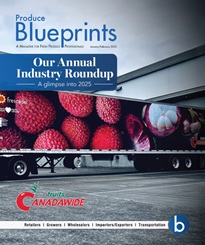There is no denying that we are in the throes of the dog days of summer. As we begin this week, heat is the most widespread weather hazard across Central and North America growing regions. However, temporary relief is forecast for at least a portion of the U.S.
Mid-week rain and a cold front will sweep through the Eastern portion of the U.S., turning on “nature’s air conditioning.” Temperatures from the Midwest and eastward will likely trend 5-10 degrees below average, providing much-needed respite to growers and farmworkers harvesting everything from tomatoes to peppers and beans.
Growers in the West won’t be as lucky. Excessive heat maintains a firm grasp on Western growers from Washington to Mexico. While many “warm” crops, such as bell peppers, melons, and tomatoes, are faring better than cold-loving broccoli, cauliflower, and lettuce, the overall supply of affected crops is trending downward due to heat-related pressure and seasonal transition.
The remnants of Hurricane Beryl brought much-needed rain to the drought and heat-stricken Midwest and Northeast. Growers in some states, such as Vermont, experienced heavy flooding. While flood-related losses will affect produce markets at the local level, they shouldn’t distress produce supply chains on a larger scale.
ProduceIQ Index: $1.26/pound, down -5.3 percentover prior week
Week #28, ending July 12th
Blue Book has teamed with ProduceIQ BB #:368175 to bring the ProduceIQ Index to its readers. The index provides a produce industry price benchmark using 40 top commodities to provide data for decision making.
Heat smothers bell pepper supply and forces prices upwards. Due to transition and high heat, Western and Eastern peppers are in a demand-exceeds-supply situation.
In the West, high heat in the desert and Central California is reducing harvesting hours and fueling quality issues. In the East, growers in Southern Georgia are finished, and growers in North Carolina, New Jersey, and Tennessee are ramping up production.
Supply is forecasted to improve over the next few weeks as more local programs become available in the East and production in Central California gains traction.
Green bell pepper prices rise past $28, and supply is difficult to find.

It’s been a very active summer season for tomato markets, and the roller coaster ride isn’t over yet. Round tomato supply seems to be improving thanks to the beginning of harvesting in Tennessee and various regional players such as Virginia, Alabama, and Arkansas.
On the other hand, tight supply and high prices are dark clouds that grape-type and plum-type tomato markets can’t seem to shake off. Grape and plum-type average prices are both at a ten-year high. Transition, heat in the West, and rain and heat in Mexico fuel high prices and tight supply. Markets are forecasted to remain active for the next two weeks.
Grape tomato prices reach new territory at $29.

Although considered somewhat heat tolerant, even grapes have their limit when enduring the inferno plaguing Western growing regions. Average grape prices are at a ten-year high and will likely climb higher over the next few weeks as high heat limits harvesting and reduces yields in Mexico and California.
Washington cherry season is in full swing, and cherry markets are reveling in the fresh supplies. Average cherry prices have remained on the higher end of the historical spectrum this summer despite earlier predictions that 2024’s supply might exceed the volume we saw in last summer’s historic harvest. With the beginning of Washington’s production, prices are finally trending below average.
Cherry prices falling to $38, still above many prior years.

Please visit our website to discover how our online tools can save time and expand your reach.
ProduceIQ is an online toolset designed to improve the produce trading process for buyers and suppliers. We save you time, expand your opportunities, and provide valuable information to increase your profits.
ProduceIQ Index
The ProduceIQ Index is the fresh produce industry’s only shipping point price index. It represents the industry-wide price per pound at the location of packing for domestic produce and at the port of U.S. entry for imported produce.
ProduceIQ uses 40 top commodities to represent the industry. The Index weights each commodity dynamically, by season, as a function of the weekly 5-year rolling average Sales. Sales are calculated using the USDA’s Agricultural Marketing Service for movement and price data. The Index serves as a fair benchmark for industry price performance.



